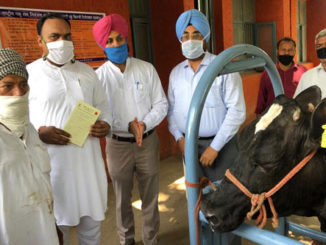Introduction
Cotton production is one of the major production crops around the World. India has the largest area under cotton cultivation in the World and India is the World’s first biggest producer of cotton. Cotton seed contain principal pigment and potent toxin name as Gossypol. Gossypol is produced by pigment glands in cotton stem, leaves, seeds and flower buds. Cotton seed meal is byproduct of cotton that is used for animal feeding because it is rich in oil and protein. However, gossypol toxicity limits cotton seed use in animal feed. Gossypol poisoning, usually chronic, cumulative and occasionally insidious, follows consumption of cottonseed or cottonseed products that contain excess free gossypol. It is of most concern in domestic livestock, especially preruminants or immature ruminants and pigs; mature ruminants are more resistant to gossypol’s toxic effects (Merck, 2008).
Case History and Clinical observation
A ten year old mid pregnant cow was presented with history of ingestion of cotton in excess amount as told by owner with difficult breathing, anorexia, distended abdomen, restlessness and salivation. The detailed clinical examination revealed that body temperature 102.8°F, congested conjunctival mucous membrane, dyspnea, rumen fluid pH 10, tachycardia and polypnea, bilateral distended abdomen (Fig.1.) with tympany. Based on the history of ingestion of cotton and detailed clinico-physiological examination case was diagnosed as Gossypol poisoning.

Treatment and Discussion
The cow was treated with Inj. DNS @ 4 lit. IV, Inj. Flunixin meglumine @ 1.1 mg /kg BW IV, Inj. Amoxicillin sodium and Sulbactam sodium @ 10 mg/kg BW IM, Inj. Metoclopramide hydrochloride @ 0.1 mg / kg BW IM, Inj. Iron sorbitol, folic acid and vitamin B12 @ 5ml IM, Magnesium sulphate @ 300 gm orally, Acetic acid 400 ml diluted in 2 lit. water orally, Liquid Bloatosil @ 100 ml orally. On 2ndday of treatment animal showed improvement with reduced salivation, reduced tympany, started feed intake (Fig.2.) and ruminal pH comes to normal 7.5. Then advised to give ferrous sulphate bolus 2 bid orally.

The gossypol absorption rate is inversely proportional to amount of iron in the diet and dietary supplementation with ferrous sulphate inactivates free gossypol. Due to this in this case orally ferrous sulphate given which result into the total recovery of an animal after third day successful treatment. After 3rd day of treatment cow recovered completely. The prolonged excess gossypol exposure in animal feed results in reduced growth rate, weight loss, weakness, anorexia and increased susceptibility to stress. Adult dairy cattle may show weakness, depression, anorexia, edema of brisket and dyspnea and also have gastroenteritis, hemoglobinuria and reproductive problem. The most common toxic effects is the impairment of male and female reproduction (Ivana Cristina N. Gadelha., 2014). Follow up of case has been taken after discharge and owner informed that cow given twin calf with normal parturition (Fig.3.)

References:
- Ivana Cristina N. Gadelha , Nayanna Brunna S. Fonseca , Silvia Catarina S. Oloris , Marilia M. Melo and Benito Soto-Bianco (2104) Gossypol Toxicity from Cottonseed Products. The Scientific World Journal. Volume 2014, Article ID 231635, 11 pages.
- Merck (2008) The Merck Veterinary Manual. 8th Edn. Merck & CO., INC. Whitehouse station, N.J. USA.
|
The content of the articles are accurate and true to the best of the author’s knowledge. It is not meant to substitute for diagnosis, prognosis, treatment, prescription, or formal and individualized advice from a veterinary medical professional. Animals exhibiting signs and symptoms of distress should be seen by a veterinarian immediately. |






Nic aricle.. Very informative.. Thank you
Nice and informative article 👍
This is bestt Information..
Much descriptive and experience writting..
Can b used for future Research and Training purpose
Plzz do Write and continue the work…
Nice article doctor..thanks for sharing such nice information…keep it up
Informative Article…
This is so enlightening Article….
Plzz Do Post Such ….
Looking forward to follow your writting…
Nice Article.. Well done doctor thank you so much for sharing such useful knowledge with us.. Fabulous article
Informative one
One of the BEST Article….
Much Enlightened Information..
Keep IT up….😊😊
Nice article each and everything described in simple & in understandable way 👍👍
Very informative and nice article Dr